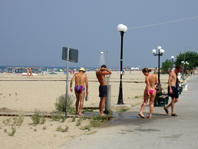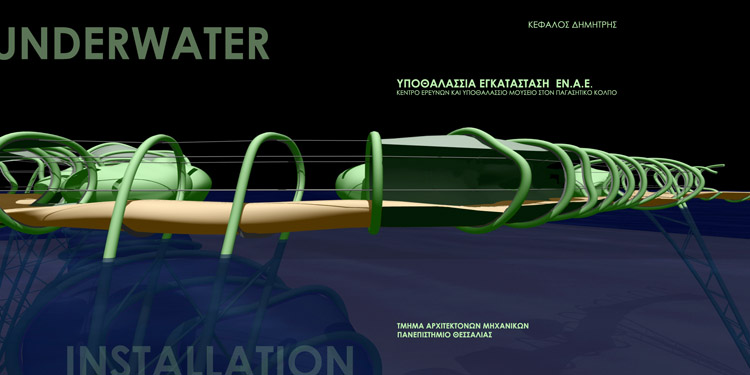

The students’ independent inhabitation during their studies, is one with special features. It has a permanent character (for about 5 years) but also temporary provided that, after some time there will be locomotion to a place of habitation. It usually constitutes the first independent inhabitation (outside family house) for the majority of students.
Inside student’s habitation, mechanisms of usurpation and socialization are being evolved. Research in the framework of the researching project has shown that students’ inhabitation of today, takes effect under difficult circumstances. Most of the times their habitations don’t correspond to their way of living.
During their studies, they inhabit either in dorms or in flats which are not designed for students’ inhabitation. In dorms, a part of privacy is being deprived of, as they are supposed to share some spaces with other students. In flats of apartment buildings, students do have the desired privacy but due to the fact that the flat is not designed for students’ inhabitation, they don’t have the functionality and the suppleness they desire.
Subject of the diploma project is the planning of a student’s habitation complex model. The objective is the exploration and the planning of the contemporary inhabitation so as to content needs of functionality, utterance, collaboration and privacy of today’s student.
The approach method was based on the consequents of the researching project and also on the results of a research that took place among students. The research was based on floor plans, made by students, in a pattern of vertical and horizontal lines, which create 8*8 units. The floor plans contain the desired spaces and the desired usage of spaces, for each student. The intention was the conception of each student’s desires in regard of habitation’s spaces and suppleness. The data collection of the desired usages was the starting point of the plastic construction which led to 4 types of inhabitation. The student, himself, will administer the desired usages and spaces by using guides that subsist in the floor. Walls are going to be placed in these guides, afterwards.
The combination of the types is done due to a scenario which originates interpersonal relations in public spaces of the complex model and restrains students’ privacy inside the habitation.
Supervisor: Trova Vasso
Reference Number: 56




Lavrion was one of the few industrial cities of Greece. The city’s life was directly connected with the function of the mining company and consequently, the transition to a post industrial phase was problematic. The cityscape is composed by the relics of the mines, a carven landscape ending to the sea. Today the city is about to be included in Attica’s expanding network of transport by connecting the harbor to the airport by railroad.
This project proposes a railroad terminal which functions as gate of entry to the city and to the different means of transport that it connects, organising a network of movements of pedestrians, trains and vehicles, incorporating elements of the city, and re-defining the significance of non-place that characterizes the modern stations.
The process that was followed in project aims to deconstruct, reform, and inhabit the land. The main concept is to open up the earth in order to create architectural forms in a way that landscape merges with architecture. The construction functions as an organ that carves the earth. It extracts pieces from the land mass while at the same time it is called to substitute the empty interval that was created, shaping spaces which take in all the programmatic needs of a terminal. A new natural topography is formed, in which the fragments of the building can be considered as modern splinters emerging from the insides of the earth.
Supervisor: Papadopoulos Spiros
Reference Number: 70


Thessaloniki is a city closely related to the cinema lifetime and history. Currently, the city harbour is being upgraded into a highly cultural activity area, due to the functioning of three Museums: Cinema, Photography & Modern Art, and to many cinemas and cultural happenings which take place at the first pier.
The thesis proposal refers to the construction of a Film Library – Cinema Research Centre in the first pier of the harbour. The Film Library will constitute a non-speculative organisation aiming at research, concentration, reservation and provision of the greek and international cinema heritage. Today, the Film Library is housed in a part of the Cinema Museum, where it has a limited function and usage. By transferring the Film Library to the new building, the creation of a self-sustained space in combination with providing the necessary infrastructure for cinema research activities, is being proposed.
Initial concept of the synthesis is the construction of a film screen on the main side of the building, visible from the city’s seafront.
The aim of the synthesis is to create a public path which will commence from the Cinema Museum and end inside the new building. This path is combined with the functioning of the Film Museum, but also consists of other paths which already exist according to the current activities of the pier.
Morphologically the building comprises of two different parts. The first one accommodates the main functionalities of the Film Library, whereas the other has a more public character and offers activities which relate to the visitor and the wider public. The basic features of a cinema theatre –namely the projection cabin, the pit and the screen- composed a synthesis instrument of the central part of the atrium.
The pier itself, in the whole building synthesis, functions as a marina, as sailing nowadays is a recreational activity and boats cross the Thermaikos Gulf regularly on a daily basis. Thus the pier formulates a seawater axis in line with the seafront of the city.
Supervisor: Manolidis Kostas
Reference Number: 55


This project consists of two stages. The first stage explores the relationship between the landscape and its “objects” and the second stage deals with the further relationship between the “new” objects and the landscape.
During the first stage derivations take place and found objects are collected. Subsequent mental stimulation leads to the following stage which explores the collected ideas and animates them into two physical structures, which eventually are placed back to the landscape.
Supervisor: Tzirtzilakis Yorgos
Reference Number: 65






The Underwater Installation M.A.R. is a centre from which is made the management of the maritime wealth of the west coast of the south Pagassitikos gulf. It serves the needs of the Institute of maritime archaeological researches and it aims for the education and the entertainment of the visitors. The fact that 8 shipwrecks are traced there, that are chronologically included from the early roman to the Byzantine times, it constituted the cause that the installation is placed in the location between steni Agali and the Tilegraphos creek. Its position offers directness in the work of the archaeologists and for the diving of the divers that are pulling out the ancient discoveries.
In real-time it is possible to observe the underwater work of the divers and their direction with the best way. The discoveries are moved to the labs of the installation where works of maintenance take place and then they are placed to the underwater museum.
The installation includes the following uses:
In the land
- Parking places for cars and buses,
- access from the parking to the jetty.
In the sea
- jetty and spaces as dormitories of hospitality, rooms of storage of equipment, centre of education of new archaeologists and laboratory,
- underwater museum, theatre and electronic library,
- and also a stairwell that connects the over water with the underwater part of the installation.
Methods of energy planning are applied, so as the building can function with a relative autonomy with regard to his electricity and to reach airing of the underwater part. There are installed photovoltaic systems to the over water rinds of the installation and underwater pipes that bring fresh air in the museum.
The installation aims in the service of archaeologists of the I.M.A.R., the development of research and the management of the maritime wealth, the practicing of the new archaeologists and divers of the maritime archaeology and to the entertainment of the public that will visit it.
Supervisors: Gavrilou Evelyn, Bourdakis Vassilis, Tsangrassoulis Aris
Reference Number: 66


